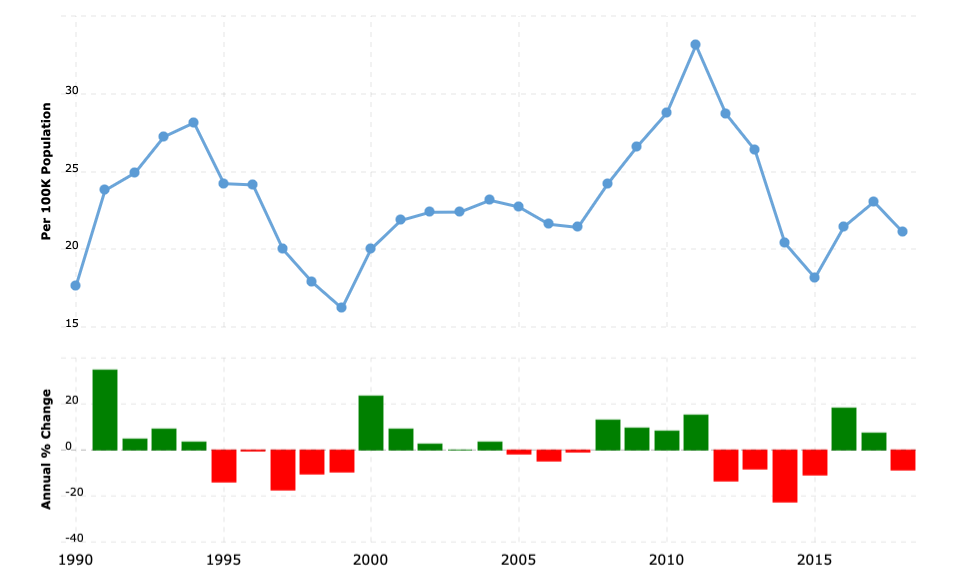One of the stranger arguments against statehood for Puerto Rico is that a state of Puerto Rico would harm the statistics for the United States, making the U.S. look bad when it comes to economic data, crime rate, and the like. The United States is responsible for its territories as much as for its states, and honest statistics already include Puerto Rico. Leaving Puerto Rico out of official statistics is not an action that lowers the crime rate of the United States. It just covers up the problems Puerto Rico has from being a territory.
But just how is the crime rate in Puerto Rico?
Puerto Rico’s homicide rate
Puerto Rico’s homicide rate, as you can see in the chart below, peaked in 2010 and fell in 2015, followed by rises and falls that brought it back to the median by 2018, the last year for which the World Data Bank lists figures.
According to the World Data Atlas, there was a further drop of 19.75 % in 2020. The most recent figure we found was 18.5 homicides per 100,000 in population as of 2020.
Compare this with the overall U.S., which had 7 homicides per 100,000 people in 2020, up from 5 per 100,000 in 2018.
Puerto Rico’s overall crime rate
Puerto Rico’s homicide rate is higher than the U.S. but the overall crime rate in Puerto Rico is lower than average for the United States.
FBI figures show that violent crimes in the U.S. overall (including Puerto Rico) stood at 370.3 per 100,000 inhabitants, and property crime rates at 2,582.1 per 100,000. In Puerto Rico in particular, the numbers were 224.0 violent crimes per 100,000 and 1,031.9 property crimes per 100,000.
Puerto Rico’s crime rate is therefore almost 40% lower than the national average. Compare it with Arkansas, a state with about the same population as Puerto Rico. In 2016, Arkansas had 550.9 violent crimes and 3,268.6 property crimes per 100,000 residents. Another example is Nevada, again with a similar population size, which had 678.1 violent crimes and 2,586.6 property crimes per 100,000 in population.
Causes of the crime rate
Puerto Rico’s crime rate is driven by a number of factors, as is true in states as well. Poverty is a major problem on the island, with nearly half of the population living below the poverty line. This can lead to desperation and crime as people try to make ends meet.
Puerto Rico is a major transit point for drugs coming into the United States. Puerto Rico has less federal law enforcement investment than the borders with Canada and Mexico, and transit from Puerto Rico to the U.S. mainland is easy. This creates a market for illegal drugs, which can lead to violence.
Under the circumstances, Puerto Rico should be proud of having a lower than average crime rate. But every territory that has become a state found that crime and violence were reduced after statehood. Puerto Rico’s crime rate can be expected to improve after the Island becomes a state.








No responses yet